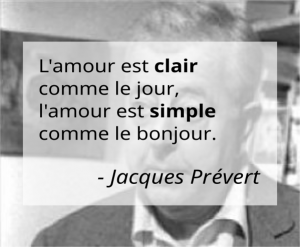French adjectives
Les adjectifs
Salut, and welcome to our lesson about French adjectives at Language Easy! It’s an important lesson, because using more adjectives in your sentences (and using them well) will help you express yourself in a much more colorful way. We’ll guide you through the subject!
Allez, on y va !
What are French adjectives ?
Qu’est ce que les adjectifs ?
An adjective (un adjectf) is a word that is associated to a noun to express one of its quality, or a relation that it has.
French adjectives have a gender (masculine or feminine) and a number (singular or plural), and consequently they must agree with the noun that they determine.
Let’s give a few examples already :
- Le gâteau est délicieux.
The cake is delicious. (a quality) - Le trône royal
The royal throne (a relation : it’s the king’s trône) - La maison royal
The royale house (note that this time, maison is feminine)
Additionally, French adjectives can receive a complement and become an adjectival group, that behaves like an single adjective :
- L’enfant est seul à la maison.
The child is home alone - Un élève doué en mathématiques.
A student who is gifted in mathematics
There are 3 different ways to use French adjectives :
- An attributive adjective (adjectif épithète) is an adjective that is used directly with the noun they determine, without the help of a verb.
- A predicative adjective (adjectif attribut) is linked to the noun with the help of a verb.
- An adjective in apposition is put between comas, like pausing the sentence to complement the noun.
Attribute adjective :
- Une maison bleue sur la colline.
A blue house on the hill.
Predicative adjective :
- Sans aucun doute, la maison sur la colline est bleue.
Without a doubt, the house on the hill is blue.
Apposition :
- La maison, bleue comme le ciel, trône sur la colline.
The house, blue as the sky, sits on the hill.
Place of the attribute French adjective
La place de l’adjectif épithète
The attributive adjective is placed after the noun.
As an exception to this rule, the following adjectives are generally placed before :
- Short appreciative adjectives
- the adjectives même, autre, and prochain
For example, note the place of the adjective at the following sentences, and how it’s different than in English :
- Marc est un homme honnête qui aime les chemises chic.
Marc is a honest man who likes trendy shirts. - C’est aussi un ami extraordinaire !
He also is an extraordinary friend!
And as I said, short and appreciative will be placed before the noun :
- Le même trajet qu’hier = the same itinerary as yesterday
- Un autre jour = another day
- Le prochain train = the next train
- Le beau château = the pretty castle
- Un petit problème = a small problem
- Une bonne attention = a good care
- La vieille voiture = the old car
- Un vilain monsieur = a mean man
- Le grand voyage = the big trip
- Un brave type = a brave guy
- …
Stay aware that some adjectives can be placed after or before the noun, but with a different meaning.
| Before the noun | After the noun |
| Mon ancienne maison = The house I lived before | Une maison ancienne = An old house |
| Un pauvre homme = a man who inspires pity | Un homme pauvre = a poor man |
| Ma propre chambre = my own bedroom | Ma chambre propre = my clean bedroom |
| Un sacré livre = a incredible book | Un livre sacré = a sacred book |
| Ce seul homme = This man alone Seul cet homme = Only this man |
Cet homme seul = this lonely man |
| Un simple repas = only a meal | Un repas simple = a simple meal |
| … |
Gender of the French adjectives
Le genre des adjectifs français
The mark of the feminine for French adjectives is always “e“.
Generally, adding this -e at the end of a adjective is sufficient to mark its feminine :
- un poisson bleu
a blue fish - la mer est bleue
the sea is blue
- un jeune ami
a young male friend - une jeune amie
a young female friend
But of course there are a lot of exceptions, that we’ll discuss now.
Irregular forms of the feminine
French adjectives ending with “en“, “on“, “eil“, “il” or “ul” double the last consonant before adding the final “e” :
- dorien / dorienne = dorian
- bon / bonne = good
- pareil / pareille = identical, similar
- gentil / gentille = nice
- nul / nulle = crappy
French adjectives ending with “er” receive an accent on the last vowel before adding the final “e” :
- fier / fière = proud
French adjectives ending with “et” double their last consonant, except complet (complete), incomplet (incomplete), concret (concrete), désuet (outdated), discret (discrete), indiscret (indiscreet), secret (secret), inquiet (woried)
- douillet / douillette = comfortable
- complet / complète = complete
French adjectives ending with “gu” receive an dieresis on the “u” :
- aigu / aigüe = accute
French adjectives ending in “eur” have four different possible feminine forms, on the model of :
- acteur / actrice = acting
- rêveur / rêveuse = dreaming
- meilleur / meilleure = best
- chasseur / chasseresse = hunter
French adjectives ending in “x” have their plural in “se“, except doux (soft), roux (red haired) and faux (false) :
- jaloux / jalouse = jealous
- roux / rousse = red haired
- faux / fausse = false
- doux / douce = soft
Irregular adjectives at all
These particular words double the last consonant although they should not, according to the rule :
- paysan / paysanne = peasant
- palot / palotte = palish
- sot / sotte = idiot
- bas / basse = low
- gros / grosse = big
- épais / épaisse = thick
- gras / grasse = fat
There are a few other forms of exceptional feminines :
- long / longue = large
- neuf / neuve = new
- veuf / veuve = widow
- blanc / blanche = white
- frais / fraîche = fresh
- bénin / bénigne = benign
malin / maligne = malignant
Finally, the words chic (chic), super (super), sympa (nice) don’t change at all.
Plural of French adjectives
Le pluriel des adjectifs français
The mark of the plural for French adjectives is generally a final “s“, but not always. So let’s study the different cases.
The plural of adjectives in French is generally formed by adding an “s” at the end of the singular form :
- un grand homme / de grands hommes
= notorious men - une pomme rouge / des pommes rouges
= red apples
French adjectives already ending with “s” or “x” don’t change at their plural form :
- le bas quartier / les bas quartiers
= the suburbs - un homme roux / des hommes roux
= red haired men
French adjectives in “al” form their plural in “aux”, except fatal (fatal), final (final), bancal (wobbly), naval (naval), natal (natal), and banal (banal) :
- mon ami loyal / mes amis loyaux
= my loyal friends - ce tabouret bancal / ces tabourets bancals
= these wobbly stools
Adjective VS Present participle
Adjectif VS Participe présent
The present participle of a verb can sometimes be used as an adjective, for example :
- Choisissez un homme excellant aux jeu d’échec.
Choose a man excelling at chess.
There can be a confusion with the correspondant adjective :
- René est indéniablement un joueur excellent aux jeu d’échec.
René is indeniably an excellent chess player.
In a lot of cases, the spelling is actually exactly the same : chantant (participle) / chantant (melodious, adjective)… But even so it is very important to understand the difference, because :
The present participle is invariant, whereas the adjective must agree in gender and number with the noun.
To demonstrate this, let’s take our previous example and put it in the feminine / plural :
- Choisissez des femmes excellant aux jeu d’échec.
Choose women who are excelling at chess. - Renée et Marie sont aussi des joueuses excellentes aux jeu d’échec.
René and Marie also are excellent chess players.
Here are a few examples of French adjectives that differ from the corresponding present participle :
| Adjective | Present participle |
| équivalent = equivalent | équivalant = being equivalent to |
| violent = violent | violant = raping |
| précédent = previous | précédant = preceding |
| différent = different | différant = postponing |
| fatigant = tiresome | fatiguant = tiring |
Agreement of compound French adjectives
L’accord des adjectifs composés
Compound adjectives are adjectives that are composed by more than one word (generally two) ; they usually are connected together by a hyphen “-“. In brief, they can be a combination of nouns, adjectives, verbs, past or present participles, adverbs, prepositions, determiners.
The rule for the agreement in gender and number with the noun, for each word inside, is :
- the adverbs and other words with an adverbial value are invariant ;
- the adjectives must agree.
Let’s see some examples of compound nouns :
- un garçon sourd-muet / des filles sourdes-muettes
deaf and mute girls (lit. girls deaf-mute), adjective-adjective - l’avant-dernier train / l’avant-dernière voiture
the penultimate car (lit. the before-last car), adverb-adjective - une femme clair-voyante / des femmes clair-voyantes
clairvoyant women, adjective-participle
Let’s make a few remarks though :
In the case of plural for compound adjectives with “tout”, it varies only in the feminine :
- des hommes tout-puissants / des femmes toutes-puissantes
all-mighty women (lit. all-powerful women)
In the compound adjectives where the first word ends by “o” or “i” (in an expressive meaning), it doesn’t vary at all :
- une oeuvre tragi-comique / des oeuvres tragi-comiques
tragi-comic works
And finally, compound adjectives describing colors are invariable :
- des yeux verts
green eyes - but: des yeux vert-émeraude
emerald-green eyes
Did you know ?
Le saviez-vous ?
The terms substantive (a synonym of noun) and adjective, which are well known in grammar, also have another meaning in the field of chemistry, when applying tints and colors to textiles.
A substantive color is one that imparts its tint directly to the surface to be dyed, without an intervention of a third substance. An adjective color, on the contrary, is one that requires the intervention of a third substance, that possesses a joint attraction for the coloring principle and the substance to be dyed. This third substance is called mordant. Most of the substances used in dyeing belong to the adjective colors, and only indigo has a substance used widely as a substantive color.
Source : Wells’s Principles and Applications of Chemistry, by David A. Wells
What’s next?
C’est quoi, la suite ?
Et voilà, we reached the end of our lesson about French adjectives. Certainly, you took another big step in your study of French. Keep going, and soon you’ll be able to express yourself fluently. If you are interested, feel free to visit our blog and discover more about French language and culture.
Allez, à bientôt !



